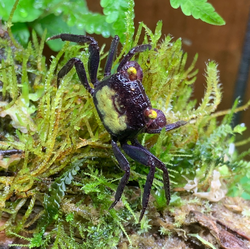Biology:Geosesarma dennerle
| Geosesarma dennerle | |
|---|---|

| |
| Scientific classification | |
| Domain: | Eukaryota |
| Kingdom: | Animalia |
| Phylum: | Arthropoda |
| Class: | Malacostraca |
| Order: | Decapoda |
| Suborder: | Pleocyemata |
| Infraorder: | Brachyura |
| Family: | Sesarmidae |
| Genus: | Geosesarma |
| Species: | G. dennerle
|
| Binomial name | |
| Geosesarma dennerle Ng, Schubart & Lukhaup, 2015[1]
| |
Geosesarma dennerle is a species of small land-living crabs found on Java, Indonesia.[1]
It is popular in the aquarium trade,[1] where G. dennerle, in particular, is often simply called Vampire Crab. Crabs called "Geosesarma bicolor Krakatau Vampirkrabbe" are probably also G. dennerle.[1]
Geosesarma dennerle is, notably, seemingly more carnivorous than other species of Geosesarma, rarely feeding on plant material or decaying plant material[2]
The species is named after the aquarium supply company Dennerle, which supported one of the describing authors' (Christian Lukhaup) study in Java.[1]
The coloration of G. dennerle can be very similar to G. bicolor. The describing paper mentions chelipeds, male abdominal and G1 structures as distinguishing features.[1]
Description
Geosesarma dennerle is a member of the phylum Arthropoda, and subphylum Crustacea. This species resides in the genus Geosesarma de Man, which comprises 56 recognized species,[3] commonly found in Southeast Asia. These crabs are generally from 1.5 to 2 inches (38 to 51 mm) in size.[4] The crab features a two-colored carapace, being predominantly purple with a patch of cream/yellow on its back. Dennerle also possesses bright yellow eyes and vibrant violet claws.[5]
As a member of the order Decapoda, this crab has 5 pairs of segmented limbs. Unlike some species of crab that have specialized claws, dennerle does not have swollen chellae.[6] The carapace is described as square-esque in shape, with well defined regions of the shell, and the abdomen being broad.[5] The ambulatory legs of this crab are generally long and thin, with broad segments.[5] Dennerle often have tubercles along its dorsal carapace, providing some texture to the otherwise smooth shell.[7]
G. dennerle are similar to other species of crabs with the occurrence of sexual dimorphism. The sex of Geosesarma species can be identified by observation of abdominal flaps. The males have narrow and pointed abdominal flaps, while the females possess wider flaps which are ovular in shape.[4] Males are also noted to be slightly larger than females.[8]
Ecology
G. dennerle is endemic to Central Java.[8]
As the prefix "geo-" suggests, G. dennerle is a terrestrial crab. It is common to find dennerle hiding in burrows in areas composed of muddy creek valleys, with rocks and dense vegetation.[5] The diet of dennerle is greatly composed of insects and plant matter.[5] The high endemism of species within the Geosesarma genus, means there is not a great amount of geographic distribution.[3]
Reproduction
Sexual reproduction in Geosesarma dennerle is similar to that of the majority of other species of crabs. Little has been observed towards specific variations in this species reproduction method in comparison to other species in the Geosesarma genus.
Members of the G. de Man genus commonly produce large eggs, averaging between 1.2 and 1.8 mm in diameter.[9] Members of Geosesarma become sexually mature around 6 months of age, with breeding consisting of the male mounting the female to fertilize eggs.[4] This species has direct development offspring: fully formed miniature versions of the adults hatch from the eggs.[9] The female will carry around 20-80 fertilized eggs for about a month before hatching occurs.[8] These newly hatched offspring are often independent, and will disperse from the point where they hatch.
References
- ↑ 1.0 1.1 1.2 1.3 1.4 1.5 Peter K. L. Ng, Christoph D. Schubart & Christian Lukhaup (2015). "New species of "vampire crabs" (Geosesarma De Man, 1892) from central Java, Indonesia, and the identity of Sesarma (Geosesarma) nodulifera De Man, 1892 (Crustacea, Brachyura, Thoracotremata, Sesarmidae)". Raffles Bulletin of Zoology. https://archive.org/details/raffles-bulletin-zoology-63-003-013.
- ↑ Hohle, Martin; Singheiser, Martin (2016). BASICS - Keeping & Breeding Vampire Crabs of the Genus Geosesarma. ISBN 9783899730531.
- ↑ 3.0 3.1 Lau, Nyok-Sean; Sam, Ka-Kei; Ahmad, Amirrudin B.; Siti, Khadijah-Ahmad; Ahmad Zafir, Abdul Wahab; Shu-Chien, Alexander Chong (2021). "Gene Arrangement and Adaptive Evolution in the Mitochondrial Genomes of Terrestrial Sesarmid Crabs Geosesarma faustum and Geosesarma penangensis". Frontiers in Ecology and Evolution 9. doi:10.3389/fevo.2021.778570. ISSN 2296-701X.
- ↑ 4.0 4.1 4.2 "Vampire Crabs: Care, Breeding, Tank Size, and Disease" (in en-US). 2021-10-13. https://theaquariumguide.com/articles/vampire-crabs-2.
- ↑ 5.0 5.1 5.2 5.3 5.4 Peter K. L. Ng, Christoph D. Schubart & Christian Lukhaup (2015). "New species of "vampire crabs" (Geosesarma De Man, 1892) from central Java, Indonesia, and the identity of Sesarma (Geosesarma) nodulifera De Man, 1892 (Crustacea, Brachyura, Thoracotremata, Sesarmidae)". Raffles Bulletin of Zoology. https://archive.org/details/raffles-bulletin-zoology-63-003-013.
- ↑ Ng, Peter. "A new genus and new species of a semi-terrestrial freshwater crab from montane tropical rainforests in Java, Indonesia (Decapoda: Brachyura: Gecarcinucidae)". https://academic.oup.com/jcb/article/38/3/341/4931177?login=true.
- ↑ Manuel-Santos, Marivene. "Two new species of Geosesarma De Man, 1892 (Crustacea: Brachyura: Sesarmidae) from Palawan, the Philippines". https://lkcnhm.nus.edu.sg/wp-content/uploads/sites/10/app/uploads/2017/06/64rbz335-342.pdf.
- ↑ 8.0 8.1 8.2 "Vampire Crab 101: Care, Habitat Setup, Tank Mates & More" (in en-US). 2020-05-08. https://www.aquariumsource.com/vampire-crab/.
- ↑ 9.0 9.1 Shy, Jhy-Yun; Ng, Peter K. L. (2019). "Geosesarmamirum, a new species of semi-terrestrial sesarmid crab (Crustacea, Decapoda, Brachyura) from central Taiwan". ZooKeys (858): 1–10. doi:10.3897/zookeys.858.35198. ISSN 1313-2989. PMID 31312087.
External links
Wikidata ☰ Q19345966 entry
 |

